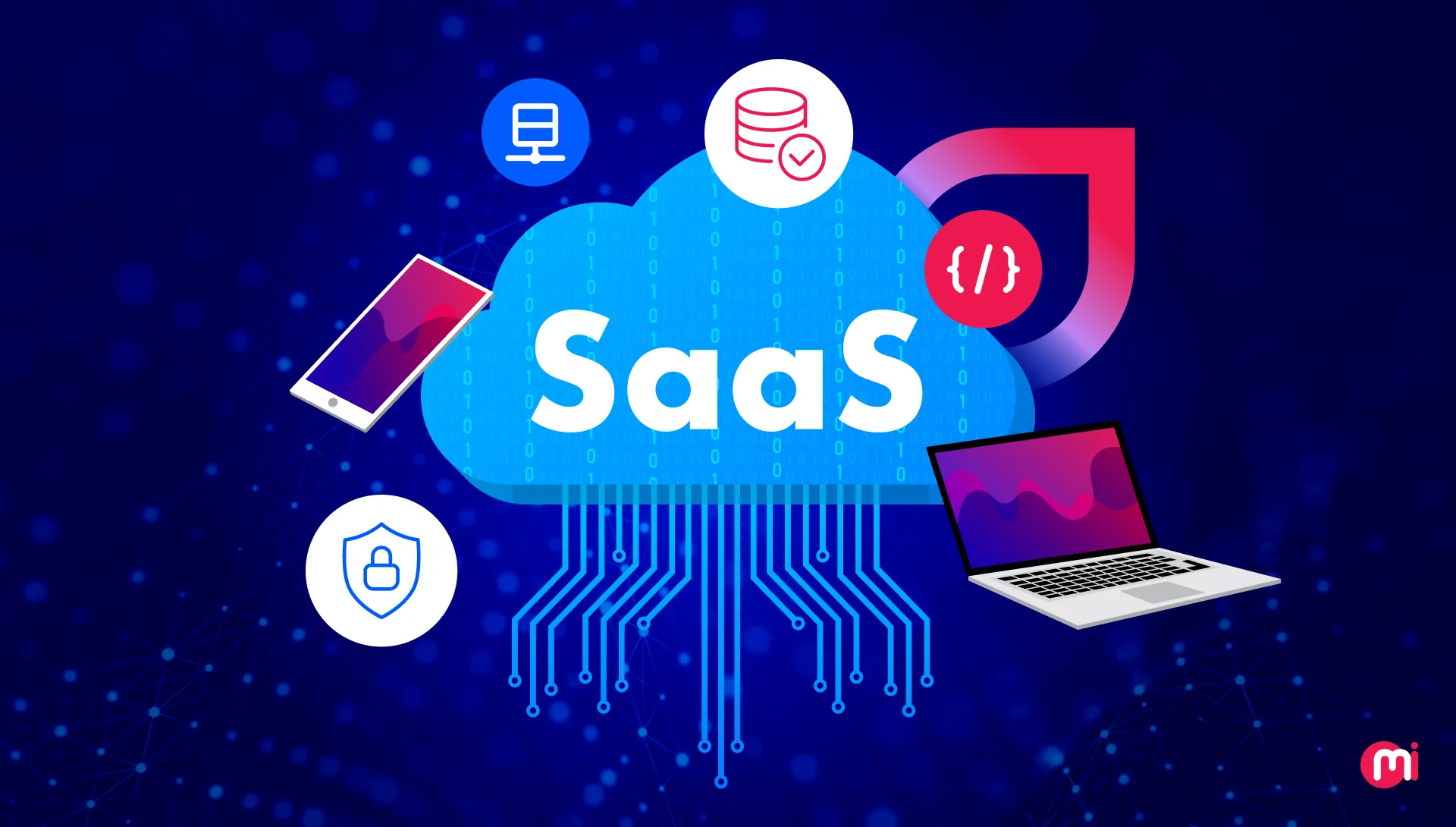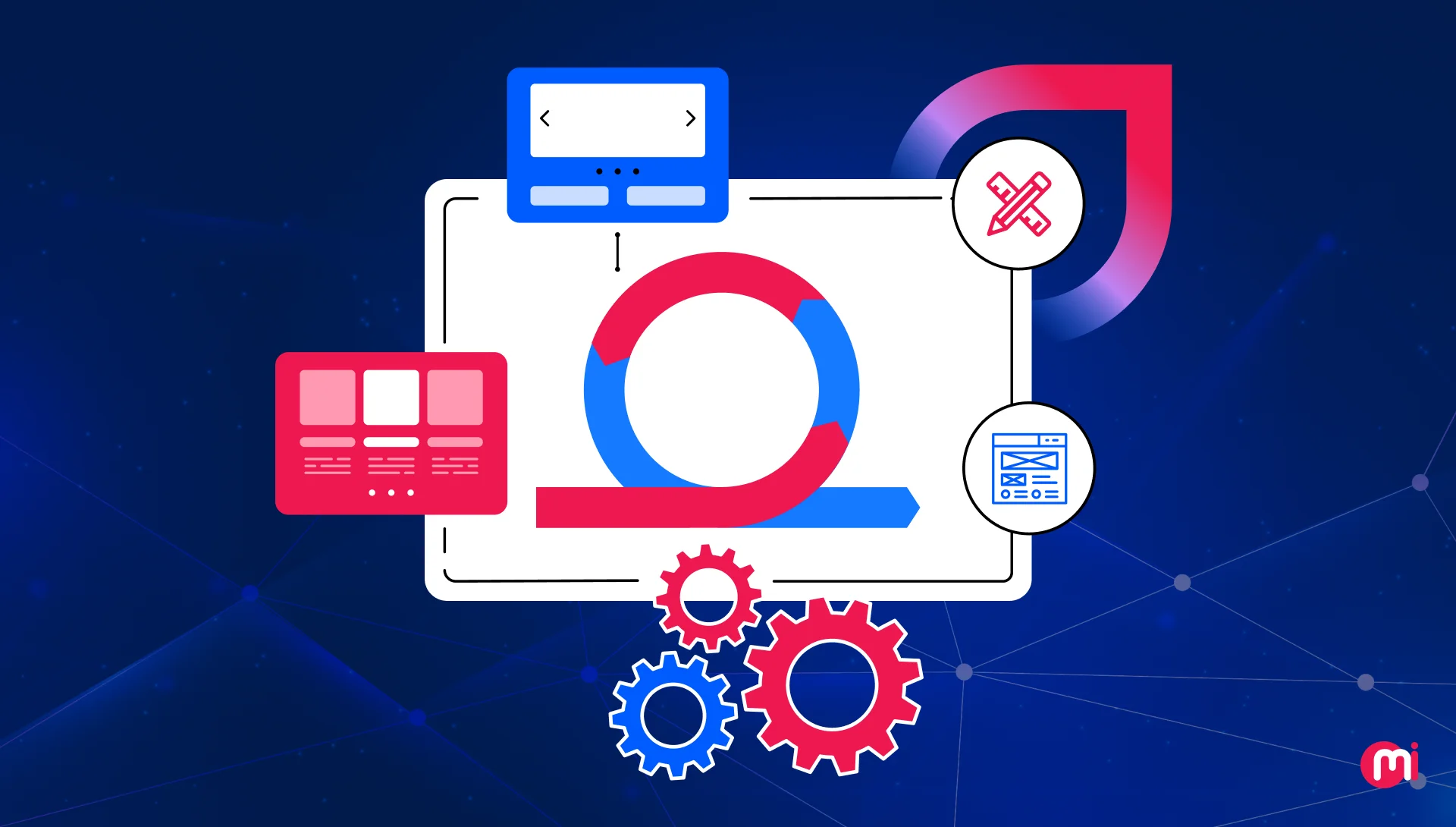The Ultimate Guide to SaaS Product Design: From UX Principles to Future Trends
- UI/UX
- October 16, 2025
According to Forbes, poor SaaS product design causes the failure of the majority of SaaS startups. From lack of market need to poor product-market fit, inadequate user experience, and ineffective marketing strategy, there are many aspects that, if not taken care of properly during SaaS design & development, lead to the project’s failure.
While a poorly designed SaaS product is frustrating, confusing, and easily abandoned, an intuitive, elegant, and user-focused SaaS product design drives adoption, retention, and growth. And, that’s what successful SaaS companies, such as Stripe and Salesforce, know and design their products accordingly to ensure success.
So, if you’re an aspiring SaaS startup, know that businesses rely on SaaS to streamline operations, scale quickly, and deliver value to customers at speed. Hence, you should design your product in the same way to succeed in this fierce competition.

This blog explores the top SaaS product design trends, core principles, best practices, and examples that illustrate what great SaaS design looks like. It helps you know everything beforehand, find a well-deserving SaaS development company, and design your product to meet users’ needs.
Key Takeaways
- AI and automation are redefining SaaS value creation, enabling smarter workflows, predictive insights, and hyper-personalized user experiences.
- Vertical and Micro-SaaS models are driving deeper specialization, helping companies serve niche markets with precision and scalability.
- Flexible, usage-based pricing and composable architectures are empowering customers with more control, transparency, and adaptability.
- Data privacy, embedded cybersecurity, and ethical practices are becoming key differentiators for customer trust and long-term growth.
- Global expansion and sustainability-focused innovation mark the next phase of SaaS evolution, where intelligent design meets responsible scale.
What is SaaS Product Design?
SaaS product design is a user-centered process of creating intuitive, effective, and visually appealing user interfaces (UI) and user experiences (UX) for cloud-based, subscription-based software services.
SaaS product design aims to make the product intuitive, aesthetically pleasing, and user-friendly so users can complete their tasks effectively, which results in higher user success and retention. Hence, success in the business.
SaaS UX design requires a designer to understand user needs, devise a user-centered design plan, leverage established design patterns, and refine wireframes and prototypes with the goal of providing a cohesive experience across a range of devices.
Explore the complete SaaS development guide for detailed knowledge about SaaS product design and development.
Why is Design Crucial for a SaaS Solution?
In SaaS software development, design is a crucial phase because it affects user experience directly, which has an effect on customer acquisition, retention, and loyalty. Distinctive and innovative design features can make users pick your product over competitors, which directly affects revenue and business expansion.
An efficient and well-functional SaaS product simplifies the process, boosts operational efficiency, differentiates the software, establishes trust, and strengthens future growth. Some of the essential reasons to prioritize SaaS design are outlined below:
- Increases Engagement: When you prioritize end-users and make the interface user-friendly & aesthetically pleasing, it makes the product more intuitive, allowing users to complete tasks efficiently and leading to higher engagement.
- Empowers Users: A well-designed solution feels seamless and allows users to focus on their work. It makes them feel more confident and satisfied with the product.
- Builds Trust: A clean, clear, intuitive, and consistent design of a SaaS helps build trust with users, which plays a crucial role in fostering long-term relationships and customer loyalty.
- Provides Differentiation: In a crowded SaaS market, an exceptional design of your SaaS product makes it stand out and offers a significant competitive edge beyond just functionality.
- Supports User-Centricity: Designers employ analytics and user feedback to create personalized, data-driven designs capable of catering to specific user needs, leading to higher personal delight.
If you’re not sure about the difference between cloud and SaaS, don’t take them interchangeably; rather, analyze cloud vs SaaS and differentiate them for a clear understanding of the concept.
What are the Top Trends in SaaS Product Design?
Top SaaS product design trends include AI-powered features for personalized & autonomous experiences, mobile-first and responsive design for seamless on-the-go use, and increased accessibility to cater to diverse user needs.
Additionally, the trends involve creating intuitive interfaces with whitespace, utilizing data-rich visualizations, incorporating real-time collaboration, interactive micro-interactions, and many other elements.
Here’s a detailed exploration of the top SaaS development trends you should consider:
1. User-Centric & Personalized Experiences
Modern SaaS solutions are designed with people in mind. Instead of a one-size-fits-all approach, they adapt to individual users’ workflows and preferences. AI-driven personalization, adaptive UI, and hyper-personalization make them adaptive to users’ needs.
- AI-Driven Personalization: Using machine learning and recommendation algorithms to create customized experiences for each user. It does so by analyzing user history and behavior to tailor the dashboard, suggest features, and predict the next step, enabling them to save a significant amount of time and feel understood.
- Adaptive User-Interface: Interfaces adjust automatically based on the user’s role or context. For example, an admin sees analytics and permissions, while an end-user sees streamlined task views, ensuring relevance while limiting clutter.
Businesses can’t afford to react to what their customers want; they need to anticipate their needs.
Parker Harris, co-founder — Salesforce
2. Enhanced Functionality & Integration
SaaS solutions are no longer standalone tools; they’re ecosystems designed to integrate and support smarter workflows. They do so with AI assistants, micro-interactions, and more.
- AI Assistants & Autonomous Agents: Natural language processing & automation power chatbots, copilots, and task agents schedule meetings, generate reports, or troubleshoot errors, minimizing manual work and speeding up routine tasks.
- Micro-Interactions: Subtle design elements such as hover effects, button animations, or checkmarks provide instant feedback, guide users smoothly, and make interfaces more engaging.
- Voice & Gesture Control: Speech recognition and gesture-based input expand accessibility and allow users to navigate or execute commands hands-free.
- Real-time Collaboration: Cloud-native infrastructure and WebSocket technologies support features, such as shared editing, live commenting, and synced dashboards that are essential for distributed teams.
3. Design & Interface Best Practices
SaaS UX design, keeping usability and inclusivity in mind, remains at the core of SaaS design. Here’s all about what’s needed for enhanced usability and inclusivity:
- Mobile-First & Responsive Design: Designing SaaS products with a mobile-first approach to ensure the experience is seamless and fully functional on smartphones, then scales naturally to larger devices, providing users with consistent, on-the-go access.
- Whitespace & Minimalism: Clean, uncluttered layouts that reduce cognitive load and let users focus on core tasks without distraction.
- Data Visualization: Interactive dashboards and visual reports to transform complex datasets into digestible insights. It ensures faster, more confident decision-making.
- Accessibility & API-First Design: Inclusive features such as keyboard navigation, screen reader support, and high-contrast designs foster usability for all, while API-first architecture allows convenient integrations with other tools.
4. Future-Forward Design Elements
SaaS design is pushing creative and experiential boundaries to stand out in the competitive marketplace. Using gamified elements, progressive disclosure, and neo-brutalism helps SaaS developers do so.
- Gamified Elements: Progress bars, points, and achievement badges encourage continued engagement and make routine tasks more enjoyable.
- Progressive disclosure: Revealing information gradually as needed, preventing new users from getting overwhelmed while keeping advanced features accessible for power users.
- Neo-Brutalism: A bold visual trend with raw layouts, high-contrast colors, and unconventional aesthetics that break from minimalism and give SaaS brands a distinctive edge.
SaaS design is becoming smarter with AI, more connected with integrations, more accessible with responsiveness & inclusivity, and more daring with neo-brutalism & gamification. These SaaS development trends aren’t just aesthetic; they directly influence usability, adoption, and long-term user retention.
Dive into the top SaaS trends every leader should know to be relevant in this competitive marketplace!
What are the Core Principles of SaaS Product Design?
SaaS UX design incorporates several foundational principles, including user-centricity, usability, simplicity, clarity, consistency, branding, feedback, transparency, continuous improvement, and more. Here’s an overview of the most important principles in SaaS product design:
1. User-Centricity & Usability
In SaaS solution design, the emphasis must be placed on real user needs and workflows, including challenges. This requires user research, user journey mapping, design testing, and iterations with real users.
Why it matters: Trust is built when a SaaS product works well and is useful from the first interaction, which ultimately reduces churn.
In practice: A CRM (Customer Relationship Management) software that highlights the “Add Contact” button upfront aligns with what sales teams need most often.
2. Simplicity & Clarity
SaaS software solutions come with powerful features and are likely to overwhelm users. Therefore, SaaS product design should be centered on user journey simplification, friction reduction, and step elimination.
Why it matters: A SaaS product with clear and streamlined interfaces speeds up adoption and user engagement.
In practice: Avoid exposing all advanced settings up front; use progressive disclosure to show advanced settings as users need them.
3. Consistency & Branding
When designing your SaaS product, maintain consistency in design patterns, terminology, components, and interactions throughout the project to ensure users don’t have to relearn patterns. It reduces the learning curve and creates a cohesive user experience.
Why it matters: Familiarity with your SaaS product builds confidence, while strong branding improves recall and trust, fostering a better user experience.
In practice: Buttons should behave the same everywhere, and error messages must carry the same tone across the platform.
4. Feedback & Transparency
For an improved user experience, your users need clear signals that the system is responding. Right from loading indicators to error messages and confirmation prompts, feedback reassures users and prevents confusion.
Why it matters: A lack of feedback creates uncertainty and frustration, eventually leading to dropped tasks.
In practice: A file upload tool should show progress in real time and notify users if something fails with actionable guidance.
5. Scalability & Improvement
One of the SaaS product design principles is that it should be scalable enough. Your SaaS must be designed with growth in mind. A flexible design system allows new features, users, and integrations without breaking consistency.
Why it matters: Scalability matters because, as the user base grows and needs evolve, a scalable SaaS design ensures the product remains efficient and reliable.
In practice: Using modular components in design systems, such as buttons, cards, or forms, makes it easier to expand features while keeping the UI cohesive.
Best SaaS Product Examples with an Intuitive Design
The best SaaS products don’t succeed by accident; their design plays a central role in adoption, retention, and scalability. A few examples of top SaaS products with intuitive design are CollabCRM, Stripe, and Salesforce. Here’s how they leverage the potential of SaaS product design to succeed:
1. CollabCRM
CollabCRM is a work management software that streamlines your entire IT business workflow by helping you to manage recruitment, employees, sales & projects with a unified system. Leveraging excellent UI UX design services, it shows how simplicity and personalization can help you succeed in a crowded marketplace.
Design Strengths: Streamlined navigation, personalization, and role-based dashboards help sales teams focus on closing deals rather than facing complex interfaces.
How it Helps them Flourish: By reducing cognitive load and tailoring the experience, CollabCRM shortens onboarding time and improves productivity, making it easier for teams to adopt at scale.
2. Stripe
Stripe is an online payment processing platform that offers a suite of financial tools and services to accept payments, manage subscriptions, handle invoices, and more. Developers integrate Stripe’s APIs into websites and applications for online transactions, while its broader suite of products helps businesses with billing, fraud prevention, and other revenue operations.
Stripe demonstrates that even developer-focused tools benefit massively from excellent product design.
Design Strengths: Clean, intuitive APIs paired with dashboards that are visually simple yet powerful. Clear onboarding flows and industry-leading documentation make integration seamless.
How it Helps them Flourish: Stripe’s design-first approach lowers friction for developers, speeds up adoption, and sets a benchmark for trust and reliability in SaaS-based fintech software development.
3. Salesforce
Salesforce is a well-known SaaS company in the marketplace. It’s a CRM platform, designed specifically to boost conversions and offer every department a holistic view of each customer’s needs. As a complex enterprise tool, Salesforce leverages modular design and customization options, helping it balance power with usability, ensuring scalability for businesses of all sizes.
Salesforce proves that enterprise-grade tools can balance complexity with usability.
Design Strengths: Salesforce’s design strengths include modular design systems, highly customizable dashboards, and a consistent interface across countless features.
How it Helps them Flourish: Even with its vast feature set, Salesforce’s design ensures scalability for businesses of all sizes, making it flexible enough for startups yet robust enough for Fortune 500s, including Walmart, Amazon Web Services (AWS), Toyota, and American Express.
What are the Best Practices for SaaS Product Design?
SaaS product design isn’t just about visual appeal but goes beyond, consisting of prioritizing first impressions, leveraging data & user feedback for improvement, ensuring accessibility & inclusion, and more. The best SaaS product development follows proven best practices that improve usability, adoption, and long-term growth.
1. Prioritize First Impressions & Smooth Onboarding
The first impression and experience of the users with your product sets the tone for user adoption. Smooth onboarding walks users through core features, provides tooltips, and offers contextual help. It’s crucial in SaaS because when users feel lost in the first few minutes, they’re more likely to abandon the product.
SaaS product designers can follow this practice by using guided walkthroughs, checklists, or sample data to help new users quickly achieve their “aha” moment.
2. Leverage Data and User Feedback
Your product’s design should evolve based on real-world usage data and customer input, not assumptions. You can make use of analytics tools, heatmaps, and surveys to reveal what’s working and where users struggle. When you have continuous feedback, you ensure the product solves actual pain points, not imagined ones.
For instance, if analytics show users often drop off before completing setup, consider redesigning the flow to remove barriers.
3. Optimize for Performance
A beautiful design is of no use if it feels slow. Therefore, consider performance optimization to boost user experience. Performance optimization ensures quick load times, smooth transitions, and reliable interactions. This matters because even a few seconds of lag can frustrate users and lead to churn.
You can do so by optimizing images, reducing unnecessary scripts, and using lazy loading to make the product feel lightweight and fast.
4. Adopt Modular & Component-Based Design
Instead of designing every screen from scratch, develop a design system of reusable components, like buttons, cards, modals, and so on. This ensures consistency across the product and makes scaling easier when adding new features. For example, you can use a modular system that allows you to assemble new pages quickly while maintaining the same look and feel.
5. Focus on Accessibility and Inclusion
When you design for accessibility and inclusion, it means you ensure everyone, including users from all walks of life, can use the product effectively. This design includes contrast ratios, keyboard navigation, alt text, and screen reader compatibility. Designing your SaaS product this way helps you boost accessibility, ensure compliance with standards, and create a more inclusive product.
To do so, you can test your SaaS product with accessibility tools, like screen readers, to uncover usability gaps.
6. Ensure Continuous Testing & Iteration
Consider continuous testing and iteration of your SaaS product. Frequent usability testing, A/B experiments, and iterative improvements keep the product aligned with user needs. Regular iteration prevents the product from becoming outdated or misaligned with customer expectations.
You can do so by running small tests before rolling out new features and gathering user feedback quickly to refine designs.

Design SaaS that Surpasses Standards with MindInventory
Designing your SaaS startup in a way that aligns with users’ expectations is the key to success. MindInventory, as a leading SaaS development company, delivers comprehensive SaaS software product development services to businesses of all sizes.
Be it SaaS product design, SaaS cloud migration, B2B SaaS integration, or SaaS consulting, our team does it all to meet your business needs. With 14+ years of experience, we excel at SaaS product design and build SaaS solutions that foster success. Here are some of the works that demonstrate our expertise in SaaS design and development:
We helped our client create Paints AI, a home remodeling solution that experienced remarkable growth.
Paint AI experienced:
- 100K+ app downloads
- 136% increase in orders
- 99% object recognition accuracy
- 97% accuracy for mobile AI
- 95% accuracy in applying paint
Another case study is Caulibox, London’s first brand with a reusable lunchbox scheme. We leveraged our expertise in product design and built a software that enabled our client to:
- Save 9.75L of water consumption per use
- Mitigate 237.5g of carbon dioxide emissions per use
- Reduce 2.35MJ of energy consumed per use
That’s not all about what we’ve done throughout the years; there’s a lot more you can get through a sneak peek at our portfolio. It contains numerous real-life examples of how we used our expertise to bring unique projects to life with immense success.
Now that you know the significance of SaaS product design, if you have a product to build, get in touch with our experts, who’ll help you design unique SaaS solutions to ensure optimal success and ROI.
FAQs on SaaS Product Design
The main difference between SaaS product design and traditional software design is that designing a SaaS product focuses on scalability, multi-tenancy, and continuous updates. Unlike traditional software, it must serve diverse users across devices with seamless performance.
Startups need lean, fast, and flexible designs to validate quickly, while enterprises require complex integrations, customization, and robust security in design.
Continuous iteration is essential. SaaS teams should consider minor improvements monthly or quarterly, while full redesigns should be considered every 2–3 years, based on user needs and product growth.
Key metrics to measure the success of the right SaaS design include user adoption, task completion rates, churn reduction, customer satisfaction (CSAT), and Net Promoter Score (NPS).
Popular tools include Figma, Sketch, Adobe XD, InVision, and Miro. Teams also rely on analytics tools like Hotjar and Mixpanel to inform design iterations.
Artificial intelligence (AI) and machine learning (ML) are driving some of the most significant advancements in SaaS today. These sophisticated technologies enhance the capabilities of SaaS platforms and fundamentally transform how businesses operate.
The 3-3-2-2-2 rule is the guideline that some SaaS businesses follow to maintain healthy growth. It suggests that your business should aim for 3 months of recurring revenue growth, 3 months of customer retention, 2 months of sales growth, 2 months of cash flow, and 2 months of net revenue growth.













